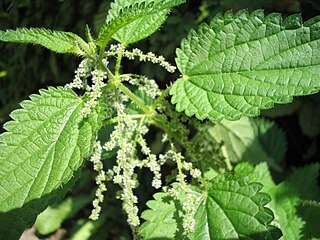
The Urticaceae are a family, the nettle family, of flowering plants. The family name comes from the genus Urtica. The Urticaceae include a number of well-known and useful plants, including nettles in the genus Urtica, ramie, māmaki, and ajlai.

Elaeagnus angustifolia, commonly called Russian olive, silver berry, oleaster, or wild olive, is a species of Elaeagnus, native to western and central Asia, Iran, from southern Russia and Kazakhstan to Turkey, parts of Pakistan and parts of India. As of 2020, it is widely established in North America as an introduced species.

Manilkara zapota, commonly known as sapodilla, sapote, chicoozapote, chicoo, chicle, naseberry, or nispero, among other names, is a long-lived, evergreen tree native to southern Mexico, Central America and the Caribbean. An example natural occurrence is in coastal Yucatán in the Petenes mangroves ecoregion, where it is a subdominant plant species. It was introduced to the Philippines during Spanish colonization. It is grown in large quantities in Mexico and in tropical Asia including India, Pakistan, Thailand, Malaysia, Cambodia, Indonesia, Vietnam, Bangladesh.

Podophyllum peltatum is an herbaceous perennial plant in the family Berberidaceae. Its common names are mayapple, American mandrake, wild mandrake, and ground lemon. It is widespread across most of the eastern United States and southeastern Canada.

Physocarpus, commonly called ninebark, is a genus of flowering plants in the family Rosaceae, native to North America and northeastern Asia.

Pilea, with 600–715 species, is the largest genus of flowering plants in the nettle family Urticaceae.
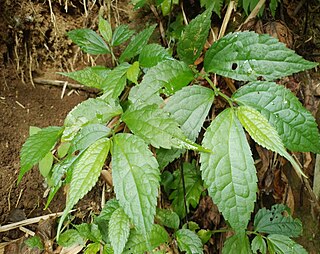
Pilea pumila, commonly known as clearweed, Canadian clearweed, coolwort or richweed, is an herbaceous plant in the nettle family (Urticaceae). It is native to Asia and eastern North America, where it is broadly distributed.

Pilea microphylla also known as angeloweed, artillery plant, joypowder plant or brilhantina is an annual plant native to Florida, Mexico, the West Indies, and tropical Central and Southern America. In the southern part of México, specifically Campeche and Mérida, the local name is Frescura. The plant belongs to the family Urticaceae. It has light green, almost succulent, stems and tiny 1/8" leaves which contribute to its other nickname, "Artillery Fern", though it is not related to ferns. It is grown as a ground cover in many areas.

Passiflora vitifolia, the perfumed passionflower, is a species of Passiflora, native to southern Central America and northwestern South America.

Rubus ursinus is a North American species of blackberry or dewberry, known by the common names California blackberry, California dewberry, Douglas berry, Pacific blackberry, Pacific dewberry and trailing blackberry.

Pilea nummulariifolia is a perennial evergreen herbaceous plant commonly known as creeping charlie native to the Caribbean and northern South America. It can be grown indoors, for example in a hanging pot.
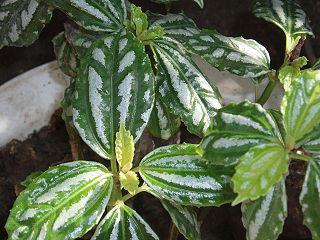
Pilea cadierei is a species of flowering plant in the nettle family Urticaceae. The species is endemic to the southern Chinese provinces of Guizhou and Yunnan, as well as Vietnam. The specific epithet cadierei refers to the 20th-century botanist R.P. Cadière. P. cadierei has earned the Royal Horticultural Society's Award of Garden Merit for its hardiness and reliability as a houseplant. In warmer countries, usually within USDA zones 8-12, the plant may be grown outside year-round as a perennial, either in-ground or contained, and pruned about 50% during the autumn.

Pilea depressa, the depressed clearweed, also sold as kiereweed, is a plant native to the Caribbean.

Pilea involucrata, commonly called the friendship plant, is a bushy trailing plant which is sometimes cultivated, especially where high humidity can be provided, such as in a terrarium. It is native to Central and South America.
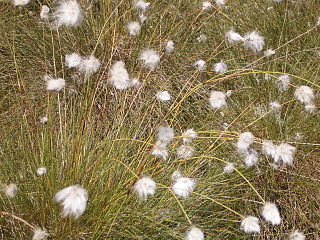
Eriophorum vaginatum, the hare's-tail cottongrass, tussock cottongrass, or sheathed cottonsedge, is a species of perennial herbaceous flowering plant in the sedge family Cyperaceae. It is native to bogs and other acidic wetlands throughout the Holarctic Kingdom. It is a 30–60 cm high tussock-forming plant with solitary spikes.

Solidago albopilosa is a rare species of flowering plant in the family Asteraceae known by the common name whitehair goldenrod.
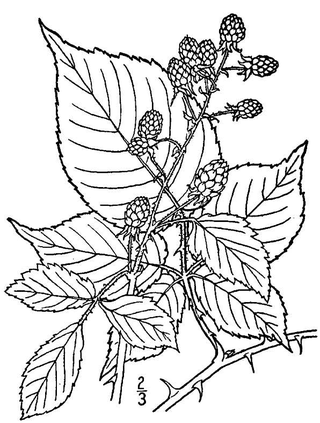
Rubus allegheniensis is a North American species of highbush blackberry in section Alleghenienses of the genus Rubus, a member of the rose family. It is the most common and widespread highbush blackberry in eastern and central North America. It is commonly known as Allegheny blackberry.
Clearweed is a common name for several plants and may refer to:
Pilea elegans is a species in the plant family Urticaceae. It is found in Chile. USDA hardiness zone 9. The plant does not tolerate snow, but can tolerate occasional freezing spells of about -5 degrees C. Light requirements consist of indirect light/low light Can be found in deep ravines in Chile facing south with additional shadow from trees, or where there is a very dense vegetation cover which gives 80 - 100 % shadow
















